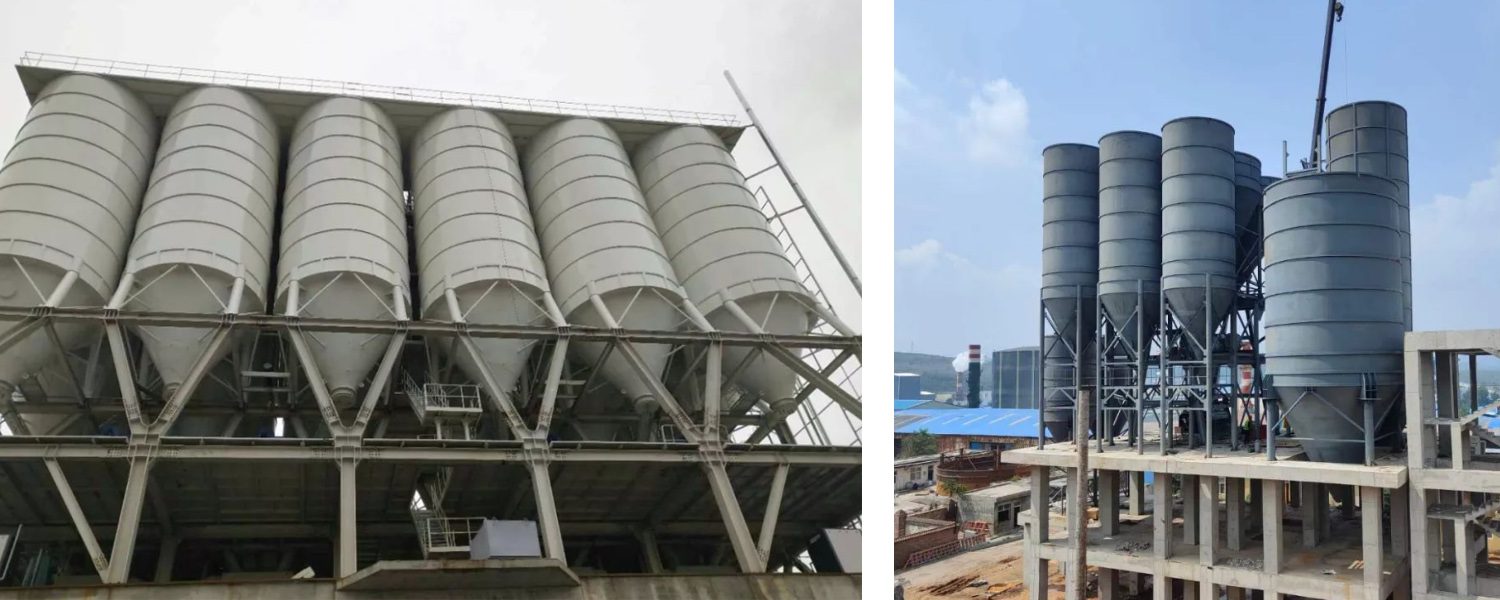Les bases du silo à ciment
1. Qu'est-ce qu'un silo à ciment ?
A silo à ciment est une structure de stockage vertical pour le ciment en vrac. Elle a trois fonctions principales :
- Permet un stockage étanche à l'air: Cela permet d'éviter l'humidité et la contamination.
- Travaille avec des systèmes pneumatiques: Il permet une alimentation automatisée.
- Intégration de modules industriels: Il s'agit notamment du pesage, du dépoussiérage et du cassage d'arches.
Types courants de silos à ciment :
- Silos en acier soudé: Le meilleur pour la portabilité et l'installation rapide.
- Silos en spirale: Rentable pour les usines de taille moyenne, idéal pour les entreprises soucieuses de leur budget.
- Silos à béton: Idéal pour le stockage à grande échelle, adapté aux besoins de grande capacité.
2. Comment fonctionne un silo ?
Le processus d'acheminement des matériaux est le suivant :
- Les pompes à air se remplissent par le haut.
- Les matériaux s'empilent naturellement dans le cône.
- La décharge du fond se produit par fluidification de l'air ou par vibration.
- Un convoyeur à vis permet d'obtenir des quantités mesurées.
Composants clés :
- Dépoussiéreur supérieur (système à jet pulsé).
- Capteurs de niveau (type radiofréquence ou radar).
- Activateurs de cônes (lits fluidisés ou moteurs vibrants).

Problèmes courants des silos à ciment
Question principale : Phénomène de voûte
Signes d'alerte :
✔️ Pas d'écoulement de matière à la décharge (mais le niveau est normal)
✔️ Augmentation anormale de la pression dans le système pneumatique (+15% par rapport à la ligne de base)
✔️ Vibrations et bruits inhabituels dans le silo inférieur
Données sur l'industrie :
Une voûte non résolue augmente la consommation d'énergie de 25-40%
68% des erreurs de dosage sont dues à une mauvaise circulation dans les silos
Des méthodes de prévention éprouvées
1. Conception optimale des silos
Angle du cône : Maintenir ≥55° (dépasse l'angle de repos naturel du ciment)
Taille de la sortie : Minimum 0,2× le diamètre du silo (par exemple, un silo de 4 m a besoin d'une sortie de ≥800 mm)
Traitement de surface : Le revêtement en acier électropoli réduit le frottement des parois de 30-40%
2. Contrôle de l'humidité
Cibles critiques :
| Paramètres | Cible | Méthode de contrôle |
|---|---|---|
| Humidité du ciment | <0,5% | Essai de perte au séchage |
| Point de rosée de l'air | ≤5°C en dessous de la température ambiante | Hygromètre |
| Stockage RH | <60% | Capteurs d'enregistrement des données |
Actions :
- Installez des ventilateurs déshydratants sur les évents
- Préchauffez l'air comprimé à 10-15°C au-dessus de la température ambiante.
3. Technique de promotion des flux
Comparaison :
| Méthode | Comment ça marche | Meilleur pour |
|---|---|---|
| Fluidification de l'air | Injection d'air à basse pression | Poudres fines |
| Vibrateurs | Agitation à haute fréquence | Mélanges sensibles à l'humidité |
| Canons à air | Souffles d'air pulsés | Rupture de l'arc existant |
Meilleures pratiques de maintenance
1. calendrier préventif :
- Chaque semaine : Vérifier l'absence d'accumulation dans la zone d'évacuation
- Mensuel : Test des membranes des canons à air
- Trimestriellement : Mesurer l'usure des cônes
2. manutention des matériaux :
- Utilisez toujours la méthode FIFO (First-In-First-Out).
- Évitez le stockage au-delà de 30 jours
Mesures d'urgence pour briser les voûtes
1️⃣ Étape 1 (dans les 30 minutes) :
Tirez des canons à air (≤3 impulsions)
Vérifiez la stabilité de la pression d'air (0,6-0,8MPa)
2️⃣ Phase 2 (1 heure non résolue) :
Passage à la décharge de secours
Ajouter un promoteur de flux (0,5-1L par tonne de ciment)
3️⃣ Étape 3 (4 heures et plus) :
Nettoyage manuel (nécessite un permis de travail en espace confiné)
Inspecter l'usure de la chemise du cône (tolérance maximale ≤3mm).
Questions et réponses techniques
Q : Comment choisir la taille du silo ?
R : Utilisez la formule suivante :
Utilisation journalière (tonnes) × Jours tampons (3-7) ÷ Densité apparente (1,1-1,3t/m³) = Capacité minimale
Q : Conseils pour la saison des pluies ?
R : Triple protection :
Humidité : Ajoutez des déshydratants à base de tamis moléculaires aux évents de toit.
Foudre : Résistance à la terre <4Ω
Statique : Résistance de la surface du tuyau d'évacuation <10⁶Ω
Principaux enseignements
- Maintenez toujours des angles de cône >55°.
- Surveillez l'humidité comme un faucon (<0,5% d'humidité du ciment).
- Combinez canons à air + vibrateurs pour les matériaux résistants
Si vous avez besoin de silos à ciment de haute qualité ou si vous souhaitez en savoir plus, n'hésitez pas à nous contacter. nous contacter. Darko vous fournira des solutions professionnelles et un excellent service !

